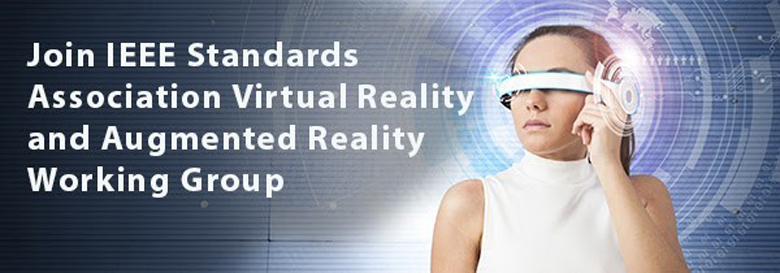
IEEE P2048 Working Group is developing twelve standards for virtual reality (VR) and augmented reality (AR). Having attracted participants from over 200 companies and institutions all over the world, the working group now is one of the largest forces dedicated to VR/AR standardization. The working group participants already include device manufacturers, content providers, service providers, technology developers, government agencies and other parties relevant to VR/AR, constituting an excellent mixture for the standards to be widely adopted.
Technology is evolving very fast, especially in VR/AR. Our current being-developed standards only cover a small piece of the VR/AR landscape. We are actively collecting and identifying standardization needs. Some of them could become new projects in the coming months. We welcome interested stakeholders to join our efforts. We seek to provide unique value in the area of VR/AR, based on our depth and breadth of technical expertise. We also are interested in collaborating with other organizations.
The twelve VR/AR standards being developed each focus on a different area of critical work, and include:
IEEE P2048.1 – Standard for Virtual Reality and Augmented Reality: Device Taxonomy and Definitions
This standard specifies the taxonomy and definitions for Virtual Reality (VR) and Augmented Reality (AR) devices. Thanks to the recent technology advances and market growth, more and more companies are producing various VR/AR devices, which include but are not limited to head mounted displays, remote controllers, sensor stations, etc. This project is needed to reduce the emerging confusion in many VR/AR devices that have similar or misleading product names but significantly different functions or performance. By dividing VR/AR devices into different categories and levels, this standard could help end users choose the right devices, facilitate the development of cross-platform content and services, and promote a healthy growth of the VR/AR industry.
IEEE P2048.2 – Standard for Virtual Reality and Augmented Reality: Immersive Video Taxonomy and Quality Metrics
This standard specifies the taxonomy and quality metrics for immersive video. Immersive video is an enabling technology behind many Virtual Reality (VR) applications in various vertical industries (e.g., media, entertainment, education, and tourism). Due to the rapid market growth recently, there have been many variants of immersive video which are different in several aspects: 360 degrees or 180 degrees, stereoscopic or not, view point movable or not, focus adjustable or not, etc. This project is needed to reduce the confusion among these variants as they are often simply called “VR video” in today’s market. By dividing immersive video into different categories and levels, this standard could help end users choose the right products, facilitate the development of cross-platform content and services, and promote a healthy growth of the VR industry.
IEEE P2048.3 – Standard for Virtual Reality and Augmented Reality: Immersive Video File and Stream Formats
This standard specifies the formats of immersive video files and streams, and the functions and interactions enabled by the formats. Immersive video is an enabling technology behind many Virtual Reality (VR) applications in various vertical industries (e.g., media, entertainment, education, and tourism). Due to the rapid market growth recently, there have been many variants of immersive video which are different in several aspects: 360 degrees or 180 degrees, stereoscopic or not, view point moveable or not, focus adjustable or not, etc. This project is needed to define the immersive video file and stream formats that support all the variants and facilitate the development of cross-platform content and services. This standard identifies existing applicable video coding standards, and defines the integration of these standards into immersive video.
IEEE P2048.4 – Standard for Virtual Reality and Augmented Reality: Person Identity
The standard specifies the requirements and methods for verifying a person’s identity in virtual reality. Many of the most important long-term applications for virtual reality, like distance education, e-commerce, work meetings, or simulation and training will rely on maintaining a meaningful representation of yourself that can travel across multiple servers. For example, you might be invited to a meeting at another company where you want to both appear as your chosen appearance (your ‘avatar’) and also be able to authenticate/prove that you are who you say you are. Similarly, you might want to go to school or go shopping as the same visual avatar. Given that VR will be a very ‘social’ medium, with many experiences depending on the presence of other people. The standard would allow a virtual reality user to; identify themselves to a site or service through a number of identity authorities; authenticate singular pieces of information without needing to trust the site with additional information; present themselves with specific visual assets; while having the visualization of their appearance certified.
IEEE P2048.5 – Standard for Virtual Reality and Augmented Reality: Environment Safety
This standard specifies recommendations for workstation and content consumption environment for Virtual Reality (VR), Augmented Reality (AR), Mixed Reality (MR) and all related devices where a digital overlay might interact with the physical world, potentially impacting users’ perception. This standard focuses on setting quality assurance and testing standards for qualifying products in said environments, achieving satisfactory safety levels for creation and consumption environment for all or majority of related products available for consumer and commercial purposes. The rise of popularity of digital/analog reality products in consumer electronics, as well as in commercial/industrial fields is requiring a balanced approach to designing a safe environment for developers and consumers. Virtual Reality and Augmented Reality enable new levels of productivity and speed up the training and content creation, yet standardization is necessary in order to provide a safe zone around the device and its operator. Standardization is viewed as the most efficient way to remove obstacles which operators or consumers might encounter, potentially including mandatory detection of objects in close proximity and releasing a warning if the interaction is deemed potentially hazardous. By providing necessary recommendations, we can reduce or eliminate potentially negative impacts which the industry faces.
IEEE P2048.6 – Standard for Virtual Reality and Augmented Reality: Immersive User Interface
This standard specifies the requirements and methods for enabling the immersive user interface in Virtual Reality (VR) applications, and the functions and interactions provided by the immersive user interface. Most of the Virtual Reality (VR) applications are supposed to provide fully immersive experiences, which could be spoiled by non-immersive user interfaces such as the ones enabled by conventional keyboards, mice, and touchscreens. The industry has recognized the necessity of immersive user interfaces in VR applications, and has put lots of efforts in designing and developing various prototypes or component technologies. This project is needed to unite these efforts and specify the baselines of immersive user interfaces in order to help facilitate the development of cross-platform content and services, and promote a healthy growth of the VR industry.
IEEE P2048.7 – Standard for Virtual Reality and Augmented Reality: Map for Virtual Objects in the Real World
This standard specifies the requirements, systems, methods, testing and verification for Augmented Reality (AR) and Mixed Reality (MR) applications to create and use a map for virtual objects in the real world. Augmented Reality (AR) and Mixed Reality (MR) applications add virtual objects on top of the real world. In many scenarios, virtual objects are supposed to be perceived as real objects so that they should have their own coordinates and orientations in the real world like real objects do. This project is needed to specify a unified map for various AR and MR applications to assign coordinates, orientations, and other arguments in the real world to virtual objects. The shared use of virtual objects among different users or even among different applications could be enabled by such a map.
IEEE P2048.8 – Standard for Virtual Reality and Augmented Reality: Interoperability between Virtual Objects and the Real World
This standard specifies the requirements, systems, methods, testing and verification for the interoperability between virtual objects and the real world in Augmented Reality (AR) and Mixed Reality (MR) applications. Augmented Reality (AR) and Mixed Reality (MR) applications add virtual objects on top of the real world. In some scenarios, virtual objects are not only perceivable as real objects, but also supposed to interact with real objects and the real world. This project is needed to define different categories and levels of the interoperability between virtual objects and the real world, and specify the systems and methods that enable these categories and levels.
IEEE P2048.9 – Standard for Virtual Reality and Augmented Reality: Immersive Audio Taxonomy and Quality Metrics
This standard specifies the taxonomy and quality metrics for immersive audio. Immersive audio is an enabling technology behind many Virtual Reality (VR) applications in various vertical industries (e.g., media, entertainment, education, and tourism). Due to the rapid market growth recently, there have been many variants of immersive audio. This project is needed to reduce the confusion among these variants. By dividing immersive audio into different categories and levels, this standard could help end users choose the right products, facilitate the development of cross-platform content and services, and promote a healthy growth of the VR industry.
IEEE P2048.10 – Standard for Virtual Reality and Augmented Reality: Immersive Audio File and Stream Formats
This standard specifies the formats of immersive audio files and streams, and the functions and interactions enabled by the formats. Immersive audio is an enabling technology behind many Virtual Reality (VR) applications in various vertical industries (e.g., media, entertainment, education, and tourism). Due to the rapid market growth recently, there have been many variants of immersive audio. This project is needed to define the immersive audio file and stream formats that support all the variants and facilitate the development of cross-platform content and services. This standard identifies existing applicable audio coding standards, and defines the integration of these standards into immersive audio.
IEEE P2048.11 – Standard for Virtual Reality and Augmented Reality: In-Vehicle Augmented Reality
This standard defines an overarching framework for Augmented Reality (AR) systems that assist drivers and/or passengers in vehicles. In-vehicle augmented reality has become a new way of providing driving assistance and other infotainment services in vehicles, and is regarded as a promising vertical application of augmented reality. It can be implemented on various devices: Head Up Displays, Smart Glasses, etc. The common point is to make the user interface more friendly while avoiding or minimizing the risk of distracted driving. This project is needed to specify the requirements and methods for applying augmented reality in vehicles, identify existing applicable standards, and define the integration of these standards into a consistent vehicular environment.
IEEE P2048.12 – Standard for Virtual Reality and Augmented Reality: Content Ratings and Descriptors
This standard defines the content ratings and descriptors for Virtual Reality (VR), Augmented Reality (AR) and Mixed Reality (MR). The immersive and realistic experiences enabled by Virtual Reality (VR), Augmented Reality (AR) and Mixed Reality (MR) enrich people’s lives, but some of them have the potential to cause mental or even physical problems (e.g. epileptic seizure). For example, unlike the situation in a theme park in the real world that people could choose not to ride a roller coaster after they see its performance and feel it is too dangerous, usually people are not fully aware of what they are facing before they put on a VR headset and enter a VR game for the first time. Even worse is the fact that people might not have the option to stop or escape when they are forced to ride a virtual roller coaster in a VR game. Hence, in addition to the traditional ratings and descriptors that address the ethical issues such as violence and sexual content, new ratings and descriptors are needed to protect people’s health and safety from risky VR/AR/MR content. This project is needed to define a comprehensive set of ratings and descriptors for VR/AR/MR content. Existing applicable standards will be identified and leveraged.
For more details, visit the VRAR – Virtual Reality and Augmented Reality Working Group webpage.
To join the IEEE P2048 Working Group, please contact Dr. Yu Yuan at y.yuan@ieee.org.
 Dr. Yu Yuan is currently serving as the Chair of IEEE Digital Senses Initiative, the Standards Chair of IEEE Consumer Electronics Society, the Chair of IEEE Virtual Reality and Augmented Reality Working Group (IEEE P2048 Standards Series), and a Board Member of IEEE Standards Association Standards Board. He is also serving on several TRB Standing Committees and IFAC Technical Committees. As a veteran researcher and practitioner in the areas of Consumer Electronics, Transportation, and Internet of Things, he has filed numerous patents and published extensively in referred conferences and journals. Dr. Yuan founded Senses Global Corporation, a multinational technology company specializing in Virtual Reality, Augmented Reality, Human Augmentation, and Smart Robots. Prior to this he had been working for IBM Research as a research scientist.
Dr. Yu Yuan is currently serving as the Chair of IEEE Digital Senses Initiative, the Standards Chair of IEEE Consumer Electronics Society, the Chair of IEEE Virtual Reality and Augmented Reality Working Group (IEEE P2048 Standards Series), and a Board Member of IEEE Standards Association Standards Board. He is also serving on several TRB Standing Committees and IFAC Technical Committees. As a veteran researcher and practitioner in the areas of Consumer Electronics, Transportation, and Internet of Things, he has filed numerous patents and published extensively in referred conferences and journals. Dr. Yuan founded Senses Global Corporation, a multinational technology company specializing in Virtual Reality, Augmented Reality, Human Augmentation, and Smart Robots. Prior to this he had been working for IBM Research as a research scientist.

